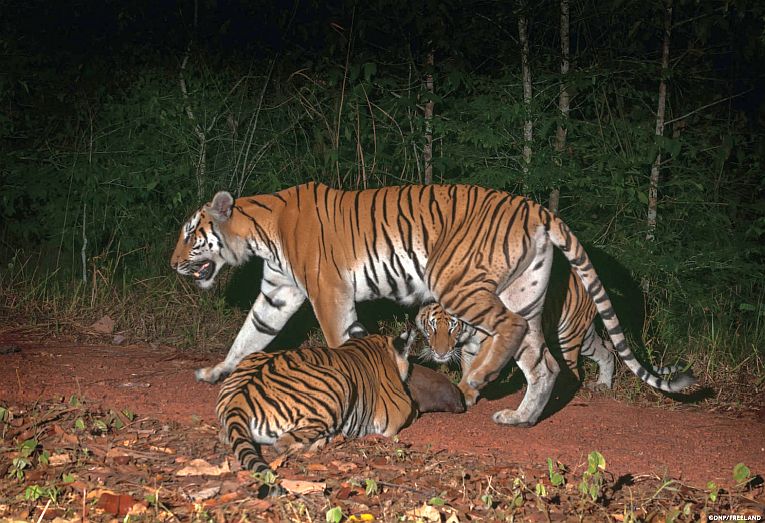Khao Yai stretches across its great mountain from just north of Bangkok, but few know that the forests that cover it stretch to the east, in a reserve known as the Dong-Phayayen Khao Yai Forest Complex. This was the first national park in Thailand and that now pays off with a discovery that the few tigers remaining in Khao Yai are part of a natural breeding group. Mongabay released this information yesterday with a flurry of international interest in what constitutes only the 2nd breeding group of Panthera tigris corbetti in Thailand. Have a good look at those remarkable pictures of tigers that were not known to exist!
This subspecies, sometimes called the Indochinese tiger, is heavily pressured because of its habitat loss and the closeness to the predatory Chinese medicine industry. The forests here are heavily protected but their history in the illegal removal of rosewoods (and tigers) has left a legacy of distrust and we certainly never expected such a positive response from the tigers.
Camera traps have revealed what wardens have little suspected. Tigers here can certainly hide, even with 6 cubs in one group. The counter-animal-trafficking organisation, Freeland and the Thai Department of National Parks collaborated with Panthera to add up a very low tiger density in the Complex (0.63/km.) In 15 years these tigers have been revealed very rarely, especially with poachers ever-present. DNP director, Songtam Suksawang declares, However, we must remain vigilant and continue these efforts, because well-armed poachers still pose a major threat.
With only 35 -58 tigers thought to be in the western Huai Kha Khaeng sanctuary, only another 150 are thought to remain in the whole of the rest of the nation.
There is an intensive patrolling system to protect all of these animals, as neighbouring Cambodia has virtually no tigers left (functionally extinct
, according to WWF, which last year set up a reintroduction programme.) Huai Kha Khaeng tigers have benefitted especially from this protection, while this eastern group have managed this increase on their own to some extent. Last April, 3890 tigers were counted, excluding this newly discovered group. A global growth in tiger numbers of up to 700 over 6 years seems like progress, but one problem could be over-confidence, and another can be miscounting.
The problem in Dong-Phayayen Khao Yai is illegal rosewood logging. In 2015 the reserve was warned of a downgrading to the World Heritage Site in Danger list The cameras will operate in real time to catch the criminals when a specialised group of rangers known as the Hasadin cannot be on hand in that particular part of the forest. This is how the tiger pictures were taken.
The future for these tigers then is not assured. 2 large new Thai roads in particular could decimate the forests because of their secondary effects, while, on the other hand,the potential for more natural tiger breeding would be invaluable for neighbouring Cambodian and even PDR Lao tiger repopulation.
How to persuade governments and people to protect these natural resources better and better. Tourism is one of the main answers. Instead of gazing at specially bred tigers in petting zoos, the attraction for visitors and Thais alike to see wild animals feeding at safe observation platforms has been successful in the past. Many don't realise what happened to these baby tigers in zoos such as Sri Racha. The mechanisms for conservation are many and varied, but we have to learn what has worked and what has not.










